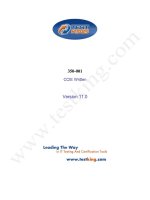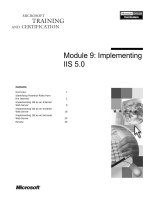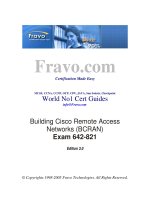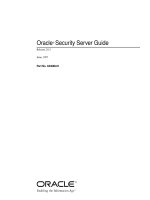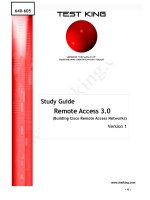Tài liệu 350-001 CCIE Written Version 24.0 docx
Bạn đang xem bản rút gọn của tài liệu. Xem và tải ngay bản đầy đủ của tài liệu tại đây (1.73 MB, 131 trang )
350-001
CCIE Written
Version 24.0
350 - 001
Leading the way in IT testing and certification tools, www.testking.com
- 2 -
Important Note, Please Read Carefully
Study Tips
This product will provide you questions and answers along with detailed explanations carefully compiled and
written by our experts. Try to understand the concepts behind the questions instead of cramming the questions.
Go through the entire document at least twice so that you make sure that you are not missing anything.
Further Material
For this test TestKing also provides:
* Online Testing. Practice the questions in an exam environment.
Try a demo: />
Latest Version
We are constantly reviewing our products. New material is added and old material is revised. Free updates are
available for 90 days after the purchase. You should check your member zone at TestKing an update 3-4 days
before the scheduled exam date.
Here is the procedure to get the latest version:
1. Go to www.testking.com
2. Click on Member zone/Log in
3. The latest versions of all purchased products are downloadable from here. Just click the links.
For most updates, it is enough just to print the new questions at the end of the new version, not the whole
document.
Feedback
Feedback on specific questions should be send to You should state: Exam number and
version, question number, and login ID.
Our experts will answer your mail promptly.
Copyright
Each pdf file contains a unique serial number associated with your particular name and contact information for
security purposes. So if we find out that a particular pdf file is being distributed by you, TestKing reserves the
right to take legal action against you according to the International Copyright Laws.
350 - 001
Leading the way in IT testing and certification tools, www.testking.com
- 3 -
Note: Answers to the unanswered questions will be provided shortly. First customer, if any, faster than us in
providing answers will receive credit for each answer provided.
Send answers to
.
QUESTION NO: 1
Load sharing of VLAN traffic over parallel ISL trunks is:
A. Not possible due to the nature of ISL.
B. Configurable on a per VLAN basis.
C. Configurable on a per packet basis.
D. Automatic due to the nature of ISL and its interaction with the IEEE Spanning Tree protocol.
Answer: B
QUESTION NO: 2
What does the EIGRP Feasibility Condition mean?
A. The FD must be unique.
B. The FD must be higher than zero.
C. The FD must be equal to RD.
D. The RD must be lower than FD.
E. None of the above.
Answer: D
Feasible Condition is met when neighbor's FD (Feasible > Distance) is less than router's current FD to same
destination.
QUESTION NO: 3
A network administrator is running OSPF demand circuit across an ISDN link. What statement is
correct?
A. The calling router must be network type point-to-point.
B. OSPF demand circuit requires network type non-broadcast.
C. OSPF demand circuit will not trigger the link if an OSPF interface goes down.
D. OSPF demand circuit will bring up the link if the topology of the network changes.
350 - 001
Leading the way in IT testing and certification tools, www.testking.com
- 4 -
Answer: A
Point-to-Point or Point-To-Multipoint
Using the OSPF demand circuit options, which suppresses Hello and LSA refresh functions, OSPF can establish
a demand link to form an adjacency and perform initial database synchronization. The adjacency remains active
even after Layer 2 of the demand circuit goes down.
Unlike the OSPF demand circuit feature, flooding reduction is usually configured on leased lines. Flooding
reduction uses same technique as demand circuits to suppress the periodic LSA refresh.
When an OSPF demand circuit is configured on a link, the periodic OSPF Hellos are suppressed. Periodic
Hellos are suppressed only on a point-to-point and point-to-multipoint network type. On any other network
type, OSPF Hellos are still sent over the interface
.
There are only two scenarios where the periodic LSA refresh occurs when using the OSPF demand circuit
feature:
•
If there is a change in network topology
•
If there is a router in the OSPF domain that can not understand demand circuits
In the first case, not much can be done to stop the LSA refresh because the router has to send the new LSA
information to update the neighbor about the topology change.
QUESTION NO: 4
In a PIMv2 Sparse Mode network, the “incoming interface” for a (*, G) mroute entry is calculated using:
A. The address of the source.
B. The address of the PIM neighbor that send the PIM (*, G) Join message.
C. The address of a directory connected member of group “G”.
D. The address of the currently active Rendezvous Point for group “G”.
E. The address of the Mapping Agent.
Answer: C
QUESTION NO: 5
Exhibit:
Existing ACEs in the VACL:
set security acl ip Control_Access permit host 10.1.1.100
350 - 001
Leading the way in IT testing and certification tools, www.testking.com
- 5 -
set security acl ip Control_Access deny 10.1.1.0 255.255.255.0
set security acl ip Control_Access permit host 172.16.84.99
set security acl ip Control_Access deny 172.16.84.0 255.255.255.128
Additional ACEs to the VACL:
set security acl ip Control_Access permit host 172.16.82.3
set security acl ip Control_Access deny host 172.17.10.44
set security acl ip Control_Access permit host 192.168.99.150
set security acl ip Control_Access deny host 192.168.250.1
A VLAN Access Control List has been configured with the four entries shown in the exhibit.
After the addition of the next four entries, how many total mask value entries are required in the
Ternary Content Addressable Memory (TCAM) table?
A. 1
B. 2
C. 3
D. 4
E. 8
Answer: C
QUESTION NO: 6
Assume a Catalyst 6500 with a Supervisor IA with a MSFC. The MSFC has lost its boot image and the
device is now in Rommon.
What method will work to load c6msfc-boot-mz.121-7a-E1-bin?
A. Xmodem
B. FTP
C. TFTP
D. SNMP
Answer: A
QUESTION NO: 7
Exhibit:
350 - 001
Leading the way in IT testing and certification tools, www.testking.com
- 6 -
In order for the DHCP client to be able to get a DHCP address upon boot, what is the minimum
configuration required?
A. Enable the command “ip helper-address 10.1.1.100” under the S0 interfaces on both Router TK1 and
Router TK2.
B. Enable the command “ip helper-address 10.1.1.100” under the E0 interface on Router TK1.
C. Enable the command “ip helper-address 10.1.1.100” under the S0 interface on Router TK1 and E0
interface on Router 2.
D. Enable the command “ip helper-address 255.255.255.255” under the E0 interface on Router TK1.
E. Enable the command “ip directed-broadcast” on all interfaces on Router TK1 and Router TK2.
Answer: B
QUESTION NO: 8
What statement is FALSE with respect to the operation of Unidirectional Link Detection?
A. It negotiates the Unidirectional Link Detection link state during physical signaling.
B. It performs tasks that autonegotiation cannot perform.
C. It works by exchanging protocol packets between the neighboring devices.
D. Both devices on the link must support Unidirectional Link Detection and have it enabled on respective
ports.
Answer: A
QUESTION NO: 9
350 - 001
Leading the way in IT testing and certification tools, www.testking.com
- 7 -
Exhibit:
Show interface command for Serial 0:
r1#sh in
Serial0 is up, line protocol is up
Hardware is HD64570
MTU 1500 bytes, BW 1544 Kbit, DLY 20000, rely 255/255, load 1/255
Encapsulation FRAME-RELAY, loopback not set, keepalive set (35 sec)
LMI enq sent 7, LMI stat recvd 7, LMI upd recvd 0, DTE LMI up
LMI enq recvd 0, LMI stat sent 0, LMI upd sent 0
LMI DLCI 0 LMI type is ANSI Annex D frame relay DTE
FR SVC disabled, LAPF stat down
Broadcast queue 0/64, broadcasts sent/dropped 2/0, interface broadcast 0
Last input 00:00:30, output 00:00:30, output hang never
Last clearing of “show interface” counters never
Queuing strategy: fifo
Output queue 0/40, 0 drops; input queue 0/75, 0 drops
5 minute input rate 0 bits/sec, 0 packets/sec
5 minute output rate 0 bits/sec, 0 packets/sec
1 packets input, 24 bytes, 0 no buffer
Received 0 broadcasts, 0 runts, 0 giants, 0 throttles
0 input errors, 0 CRC, 0 frame, 0 overrun, 0 ignored, 0 abort
4 packets output, 608 bytes, 0 underruns
0 output errors, 0 collisions, 4 interface resets
0 output buffer failures, 0 output buffers swapped out
2 carrier transitions
DCD=up DSR=up DTR=up RTS=up CTS=up
Serial 0.2 is down, line protocol is down
Hardware is HD64570
Internet address is 172.16.1.2/24
MTU 1500 bytes, BW 1544 Kbit, DLY 20000 usec, rely 255/255, load 1/255
Encapsulation FRAME-RELAY
Serial 0.3 is down, line protocol is down
Hardware is HD64570
Internet address is 171.16.2.1/24
MTU 1500 bytes, BW 1544 Kbit, DLY 20000 usec, rely 255/255, load 1/255
Encapsulation FRAME-RELAY
A serial interface is brought up, works for a short time, then goes down. According to the show interface
command what is the likely problem?
A. The encapsulation type is not set to Frame-Relay.
B. The Frame-Relay lmi-type is set improperly.
C. The interface is configured with too many sub-interfaces exceeding IDB limits.
D. The DCD not set properly for a Frame-Relay circuit.
350 - 001
Leading the way in IT testing and certification tools, www.testking.com
- 8 -
E. Keepalives are not set correctly on both ends.
Answer: B
QUESTION NO: 10
What is true concerning Traffic contract, Traffic shaping, and Traffic policing in ATM networks?
A. They are parameters of PNNI set during PNNI configuration.
B. They are forms of QoS features used in ATM networks.
C. They are types of SVCs.
D. They are types of PVCs.
E. They are only used between ATM switches to control traffic flows.
Answer: B
Traffic Shapiing, Policing, and Contract are all forms of QoS.
QUESTION NO: 11
Exhibit of the output from an ASBR:
ASBBR#show ip ospf database external
OSPF Router with ID (5.5.5.5) (Process ID 10)
Type-5 AS External Link States
LS age: 15
Options: (No TOS-capability, DC)
LS Type: AS External Link
Link State ID: 100.10.1.0 (External Network Number)
Advertising Router: 5.5.5.5
LS Seq Number: 80000002
Checksum: 0x513
Length: 36
Network Mask: /24
Metric Type: 1 (Comparable directly to link state metric)
TOS: 0
Metric: 20
Forward Address: 0.0.0.0
350 - 001
Leading the way in IT testing and certification tools, www.testking.com
- 9 -
External Route Tag: 0
And the following from a router in the network:
RouterTK1#show ip ospf border-routers
OSPF Process 10 internal Routing Table
Codes: i-intra-area route, I-Inter-area route
I5.5.5.5(2) via 30.0.0.1, Serial0/0, ASBR, Area0, SPF 4
What is the metric for subnet 100.100.1.0/24 on Router TK1?
A. 1
B. 2
C. 18
D. 20
E. 22
Answer: E
20 + 2, 20 from Metric (external), and 2 from Inter-area.
QUESTION NO: 12
Which are the primary reasons to use traffic shaping? (Select two)
A. To control the maximum rate of traffic transmitted or received on an interface.
B. To control access to available bandwidth.
C. To define Layer 3 aggregate or granular incoming or outgoing bandwidth rate limits.
D. To control the average queue size by indicating to the end hosts when they should temporarily slow
down transmission of packets.
E. To ensure that traffic conforms to the policies established for it.
Answer: B, E
Explanation: The primary reasons to use traffic shaping are to control access to available bandwidth, to ensure
that traffic conforms to specific policies, and to regulate the flow of traffic in order to avoid congestion.
Reference: />
350 - 001
Leading the way in IT testing and certification tools, www.testking.com
- 10 -
QUESTION NO: 13
In a bridged network running IEEE 802.1d spanning tree, what parameter will a bridge take form the
root bridge?
A. Maxage
B. Forwarding delay
C. Hello time
D. All of the above
Answer: D
ABC are all located in the BPDU which each switch gets from the root bridge.
QUESTION NO: 14
What statement is FALSE concerning the use of SPAN on the Catalyst 6500?
A. It is possible to configure SPAN to have a Gigabit port, such as source port, and a 10/100 port as the
destination port.
B. If the source port is configured as a trunk port, the traffic on the destination port will be tagged as well,
regardless of the configuration on the destination port.
C. When a SPAN session is active the destination port does not participate in Spanning Tree.
D. With SPAN an entire VLAN can be configured to be the source.
E. In one SPAN session it is possible to monitor multiple ports that do not belong to the same VLAN.
Answer: B
QUESTION NO: 15
Exhibit:
350 - 001
Leading the way in IT testing and certification tools, www.testking.com
- 11 -
The client can ping through the GRE tunnel to the server and receive small files just fine, but large web
page download and file transfer will fail. “debug ip icmp” on Router TK2 shows “frag. needed on DF
unreachable” messages sent to the server. Which are possible solutions to this problem? (Select all that
apply.)
A. If the physical link between Router TK1 and Router TK2 can support a MTU size greater than 1524
bytes, then increase the interface MTU between the tunnel end points to greater than 1524.
B. Decrease the physical interface MTU between the tunnel end points to less than 1476 bytes.
C. Increase the IP MTU on the tunnel interfaces to 1500.
D. Enable “ip unreachables” on all interfaces on Router TK2.
E. Check to see if there is a filtering device between Router TK2 and the server that’s blocking ICMP
messages.
If so, change the filter rule to allow ICMP
Answer: A, E
Explanation: Refer to " Why Can't I Browse the Internet when Using a GRE Tunnel?"
/>
QUESTION NO: 16
What command switches a SONET APS protected circuit over the back-up circuit?
A. aps force atm circuit-.number
B. aps manual circuit-number
C. redundancy force-failover
D. aps back-up circuit-number
350 - 001
Leading the way in IT testing and certification tools, www.testking.com
- 12 -
E. aps force circuit-number
Answer: A
A is the correct command syntax.
QUESTION NO: 17
What is NOT a BGP attribute?
A. Origin
B. Weight
C. Local_pref
D. Community
E. Cluster_list
Answer: B
Original answer was E Cluster_List is not a BGP attribute, ABCD are.
However
Actually I am not sure that weight is an attribute. It is set using the set weight command yet in Internet routing
Architectures page 116 (I believe) it does not show weight as an attribute.
Table 5-2. Attribute Type Codes
ORIGIN Well-known mandatory, Type code 1 RFC 1771
LOCAL_PREF Well-Known discretionary, Type code 5 RFC 1771
COMMUNITY Optional transitive, Type 8 RFC 1997
Cluster List Optional nontransitive, Type code 10 RFC 1966
Prefer the path with the largest weight. (Weight is a Cisco proprietary parameter, local to the router) pg 149
The difference is that the weight parameter is local to the router and is not exchanged between routers, even
internal to an AS. The weight parameter influences routes received from different providers by the same router
(for example, one router with multiple connections to two or more providers). The weight parameter has a
higher precedence than any other BGP attribute; it is used as a proprietary switch to determine route preference.
Internet routing
Architectures page 159
As you can see it is kind of confusing. I am not sure if I would go with community list answer as it is listed but
the weight is not listed yet it is referred to as a “higher precedence than any other BGP attribute”
QUESTION NO: 18
According to the IEEE 802.11b Wireless LAN specification, what sub-field is NOT part of the Frame
Control Field?
350 - 001
Leading the way in IT testing and certification tools, www.testking.com
- 13 -
A. Duration
B. Power Management
C. Wired Equivalent Privacy
D. More Fragments
E. Order
Answer: A
Duration is not a part of the FCF
QUESTION NO: 19
A switch has been configured to support MultiLayer Switching (MLS). In addition, Access Control Lists
on the MLS-Route Processor have been configured to block all FTP traffic destined to the Internet.
What flow mask will be used to create each shortcut?
A. Application flow mask.
B. Full flow mask.
C. Destination-Source flow mask-
D. Destination flow mask.
Answer: B
QUESTION NO: 20
Exhibit:
All links are 10/100
Configuration is default
350 - 001
Leading the way in IT testing and certification tools, www.testking.com
- 14 -
The exhibit shows a network consisting of only one switch port, 4/37 is being looped to port 4/30. What
statement is true?
A. Port 4/38 will be blocking.
B. Port 4/37 will be blocking.
C. Both ports will be blocking
D. Both ports will be forwarding.
E. Port 4/38 will keep transitioning between listening and learning.
Answer: A
Port priority is based on lowest priority, and lowest port number.
QUESTION NO: 21
What feature is provided by IOS NAT (Network Address Translation)?
A. Dynamic network address translation using a pool of IP addresses, or port address translation using a
single IP address.
B. Destination based address translation using either route map or extended access-list.
C. Dynamic translation for DNS “A” and “PTR” queries.
D. Inside and outside source static network translation that allows overlapping network address spaces on
the inside and the outside.
E. All of the above.
Answer: E
QUESTION NO: 22
Which statements about FTP are true?
A. FTP always uses two separate TCP sessions – one for control and one for data.
B. With passive mode FTP, both the control and data TCP sessions are initiated from the client.
C. With active mode FTP, the server used the “PORT” command to tell the client on which port it wished
to send the data.
D. For both active and passive mode FTP, the control session on the server always uses TCP port 21, and
the data session always uses TCP port 20.
Answer: A, B
350 - 001
Leading the way in IT testing and certification tools, www.testking.com
- 15 -
QUESTION NO: 23
A network administrator wants an IP static route to point to a backup link, but only if the same route is
not available via a dynamic routing protocol.
How would this be accomplished?
A. Create a static route with a lower administrative distance than the dynamic protocol.
B. Create a static route with a higher administrative distance than the dynamic protocol.
C. Create a static route with a lower metric than the dynamic protocol.
D. Create a static route with the floating-static keyword.
Answer: B
With a higher administrative distance, the dynamic routing protocol will always be the preferred route.
QUESTION NO: 24
In Token Ring networks, Layer 3 IP Multicast addresses are mapped into Layer 2 Token Ring Mac
addresses in which ways? (Select two)
A. All IP Multicast addresses are mapped to broadcast MAC address FFFF.FFFF.FFFF.
B. All IP Multicast addresses are mapped to Functional Address C000.0000.0001.
C. All IP Multicast addresses are mapped to Functional Address C000.0004.0000.
D. All IP Multicast addresses are mapped to MAC addresses using the same method as is used in Ethernet
networks.
E. Configure the Ring Parameter server to set the I/G address to 1.
Answer: C, D
See RFC 1469, IP Multicast over Token-Ring Local Area Networks
Also see />
QUESTION NO: 25
Consider the length of the netmask of a route, the administrative distance and the metric, what comes
first when the router performs a route lookup in order to decide which interface to be forwarded a
packet out of?
A. The length of the netmask of a route.
B. The administrative distance.
C. The metric.
D. None of the above.
350 - 001
Leading the way in IT testing and certification tools, www.testking.com
- 16 -
Answer: A
Most specific match is always used first.
QUESTION NO: 26
Exhibit:
In the example shown, Host 1 and 2 are both IGMPv2 speakers and are also members of group 224.1.1.1.
If Host 3 is an IGMPv1 speaker and sends an IGMPv1 Membership Report to join group 224.1.1.1, the
router will:
A. Do nothing, since there are already members of group 224.1.1.1 on the subnet.
B. Ignore all IGMPv2 Leave messages while the IGMPv1 host is a member of group 224.1.1.1.
C. Stop sending IGMPv2 Group-Specific queries in response to IGMPv1 Leaves received on this subnet for
groups 224.1.1.1, while the IGMPv1 hosts is a member of group 224.1.1.1.
D. Ignore the IGMPv1 Membership Report because the router is an IGMPv2 speaker and IGMPv1 are not
compatible.
Answer: B
With IGMP v1 and v2 on the same network, routers will revert to v1.
QUESTION NO: 27
Exhibit:
350 - 001
Leading the way in IT testing and certification tools, www.testking.com
- 17 -
Which configuration commands on Router TK1 will allow a VoIP call from Phone 1 to Phone 2?
A. dial-peer voice 3 voip
destination-pattern 7330408
session target 10.10.10.1
B. dial-peer voice 7330408 voip
destination-number 3
session-target ip 10.10.10.1
C. dial-peer voice 3 voip
destination-pattern ipv4: 10.10.10.1
session-target voice
D. dial-peer voice 3 voip
destination-pattern 7330408
session-target ipv4: 10.10.10.1
Answer: D
D is the correct syntax.
QUESTION NO: 28
What trunk mode combination would not produce an operational ISL trunk?
A. Local: auto Remote: auto
B. Local: on Remote: auto
C. Local: nonegotiate Remote: nonegotiate
D. Local: nonegotiate Remote: on
E. Local: auto Remote: desirable
Answer: A
If both sides are set to Auto, the trunk will never come up.
QUESTION NO: 29
Exhibit:
350 - 001
Leading the way in IT testing and certification tools, www.testking.com
- 18 -
RouterTK1:
no ip routing
!
source-bridge ring-group 100
source-bridge transparent 100 200 1 1
!
interface Ethernet 0
no ip address
bridge-group 1
!
InterfaceToken ring 0
no ip address
source-bridge 10 1 100
source-bridge spanning
!
bridge 1 protocol ieee
bridge 1 bitswap-layer3-addresses
Frames originating from the Ethernet device would contain which ring numbers, when observed on the
Token Ring?
A. Ring 10, Ring 2, and Ring 200.
B. Ring 200, Ring 100, and Ring 2.
C. Ring 100, Ring 200, and Ring 10.
D. Ring 10, and Ring 2.
E. Ring 2, Ring 200, and Ring 1.
Answer: B
Explanation: Configuring SR/TLB involves the configuration of SRB and transparent bridging An additional
command ties in the SRB domain with the transparent bridged domain:
source-bridge transparent ring-group pseudo-ring bridge-number tb-group
The arguments are as follows:
•
ring-group—The virtual ring group number created with the
source-bridge ring-group
command.
350 - 001
Leading the way in IT testing and certification tools, www.testking.com
- 19 -
•
pseudo-ring:—A virtual ring group number created for the transparent bridge group. The Token Ring side
sends frames to this ring number to reach the host in the transparent bridge side.
•
bridge-number:—A bridge number is assigned for the bridge between the virtual ring group and the pseudo
ring.
•
tb-group:—The transparent bridge group number configured with the
bridge-group
command.
Reference:
/>39FC-4347-81CC-F83DB20DB1D2}/st~{D7876506-1D0A-4E7E-ABC9-EE82E540D178}/session_id~{5A8B4170-A0F4-
4160-B712-93C705EEEE57}/content/articlex.asp
QUESTION NO: 30
A network administrator wants to advertise the network 135.30.45.0/27 to an EBGP peer. What
command would be used to accomplish this?
A. network 135.30.45.0 255.255.0.0
B. network 135.30.45.0 mask 255.255.255.224
C. network 135.30.45.0
D. network 135.45.0.0
Answer: B
B is the correct syntax.
QUESTION NO: 31
Exhibit:
350 - 001
Leading the way in IT testing and certification tools, www.testking.com
- 20 -
In the MPLS network shown, which subnets would be in the same Forwarding Equivalence Class (FEC)
on Router TK1:
A. 172.16.3.0/24 and 192.1.1.0/28
B. 172.16.1.0/24 and 172.16.2.0/24
C. 172.16.1.0/24 and 193.1.1.0/28
D. 172.16.1.0/24, 172.16.2.0/24, and 172.16.3.0/24
Answer: C
Both networks in answer C are along the same path, so they would both be in the same FEC.
QUESTION NO: 32
What is the maximum one-way latency allowed by the ITU that is acceptable for the majority of voice
applications?
A. 15 milliseconds
B. 30 milliseconds
C. 150 milliseconds
D. 300 milliseconds
E. 1.5 seconds
Answer: C
150 ms is the recommended maximum delay.
QUESTION NO: 33
Form ATM switched Virtual Circuits to work correctly, what is required?
A. ARP server.
B. Signalling and ILMI PVC’s.
C. QoS type set to CBR+.
D. All of the above.
Answer: B
Signaling along the path, and an ILMI PVC are required for an SVC.
350 - 001
Leading the way in IT testing and certification tools, www.testking.com
- 21 -
QUESTION NO: 34
MPLS traffic engineering routing information is carried by:
A. BGP MEDs
B. MP-BGP
C. OSPF Opaque LSAs or IS-IS TLVs
D. RTP or RTCP packets
Answer: C
QUESTION NO: 35
What type of EIGRP packets carry the Init flag embedded?
A. Hello
B. Update
C. Query
D. Reply
E. Ack
Answer: A
Only hello packets have the Init flag embedded.
QUESTION NO: 36
An AT&T 5ESS NI1 switch uses what terminal type of ISDN?
A. Terminal type A.
B. Terminal type B.
C. Terminal type C.
D. Terminal type D.
E. All of the above.
Answer: A
QUESTION NO: 37
Exhibit 1:
350 - 001
Leading the way in IT testing and certification tools, www.testking.com
- 22 -
Exhibit 2:
hostname RouterTK1
!
ipx routing 1000.1000.1000
!
interface Ethernet 0
IPX network ACA1234
!
interface Serial 0
encapsulation frame-relay
ipx network 100
frame-relay ipx 100.1000.1000.1001
!
ipx router rip
no network 100
!
ipx router EIGRP 1
!
Exhibit 3:
hostname RouterTK2
!
ipx routing 1000.1000.1001
!
interface Ethernet 0
ipx network ACA1235
ipx gns-response-delay 10
!
interface Serial 0
encapsulation frame-relay
ipx network 100
frame-relay map ipx 100.1000.1000.1000
!
ipx router rip
no network 100
350 - 001
Leading the way in IT testing and certification tools, www.testking.com
- 23 -
!
ipx router EIGRP 1
Will a workstation connected to Router TK1 be able to attach to a server attached to the Ethernet
interface on Router TK2, assuming that the Frame Relay PVCs are up and running?
A. No – Redistribution has not been configured between EIGRP and RIP.
B. No – EIGRP will not run correctly over the Frame Relay cloud.
C. No – The GNS response delay is configured on the wrong router.
D. No – The IPX routing command is not matching the Ethernet’s MAC address.
E. Yes.
Answer: D
Explanation: IPX RIP is disabled and no network has been enabled for eigrp, then no routing will take place.
QUESTION NO: 38
Which are common problems that cause clocking problems on a serial line?
A. Several cables connected together in a row.
B. Too much –db gain on the serial line.
C. Incorrect CSU configuration.
D. Impedance mismatch.
E. Incorrect DSU configuration.
Answer: A, C, E
ACE are all possible causes for clocking problems.
QUESTION NO: 39
There is a point-to-point ISDN link between Routers A and B. Router A must be able to dial Router B,
but Router B must NOT be able to dial Router A.
What will accomplish this?
A. Use an IP access-list with the access-group command on the interface.
B. Remove the dial string from Router B.
C. Use the no-dial keyword on the interface.
D. Use the same IP address on both sides of the link.
350 - 001
Leading the way in IT testing and certification tools, www.testking.com
- 24 -
Answer: B
Without a dial-string, the router will never be able to initiate a call. C is not a valid command.
QUESTION NO: 40
Exhibit:
When both L3 links in the SanJose switch fail, all users assigned to VLAN X in the Access Layer switch
cannot reach the Internet. What would be the best command to fix this problem?
A. Standby track
B. Standby timer
C. Standby authentication.
D. Standby use-bia.
E. Standby preempt.
Answer: A
350 - 001
Leading the way in IT testing and certification tools, www.testking.com
- 25 -
QUESTION NO: 41
Considering OSPF where a binding between an interface and an area has been done, what is the effect of
defining such an interface as passive?
A. OSPF will not form any adjacency out if that interface but it will accept the routing updates from the
neighbors.
B. OSPF will form all the available adjacencies out of that interface but it wont install any of the learned
routes in the local routing table.
C. OSPF will not form any adjacency out of that interface.
D. OSPF will behave as a passive adjacency at the requests coming from neighbors, lying out of the
interface, ignoring all the incoming requests.
E. None of the above.
Answer: C
With passive-interface, an adjacency will never occur out of that interface.
QUESTION NO: 42
With respect to the ATM Reference Model what is NOT one of the ATM layers?
A. Physical layer.
B. ATM adaptation layer (AAL).
C. Generic Flow Control (GFC) layer.
D. ATM layer.
Answer: C
GFC is not a layer of the ATM model.
QUESTION NO: 43
Exhibit:
priority-list 1 protocol ip medium list 102
priority-list 1 protocol ip normal list 103
priority-list 1 protocol ip low list 104
priority-list 1 default low
access-list 101 permit ip any any precedence critical
access-list 102 permit ip any any precedence flash

